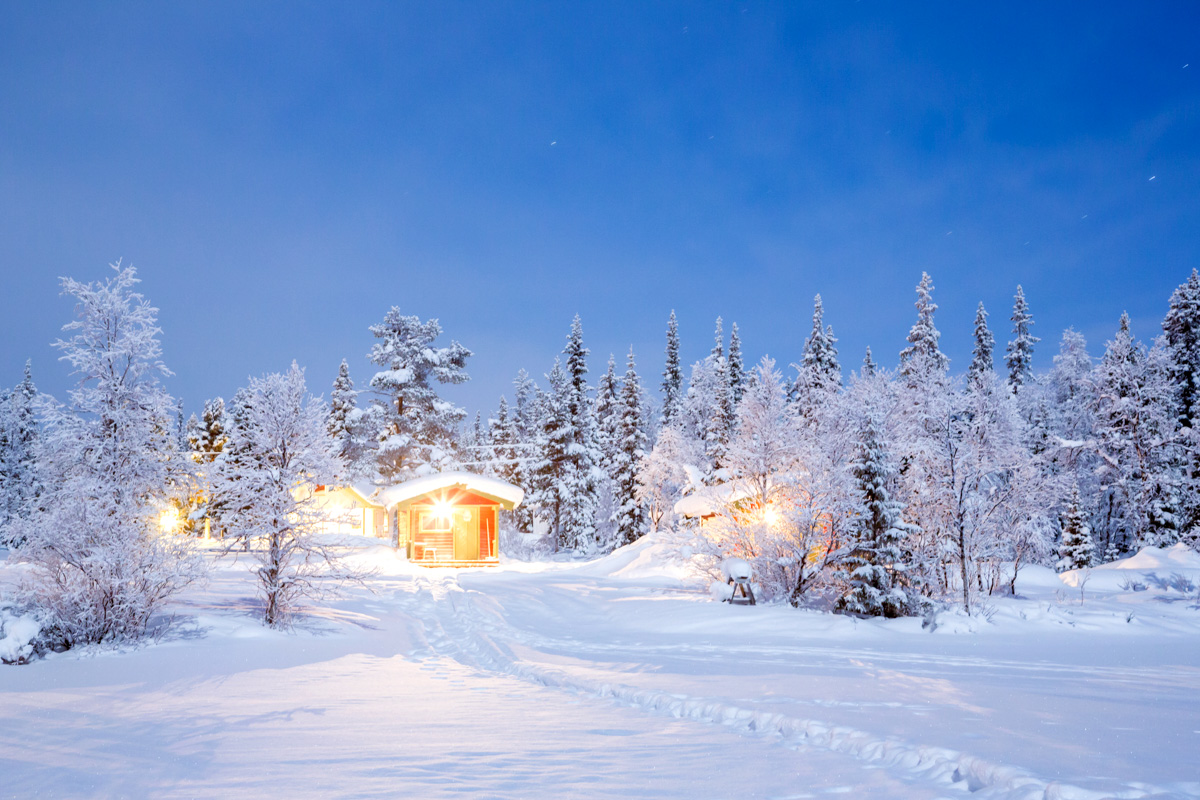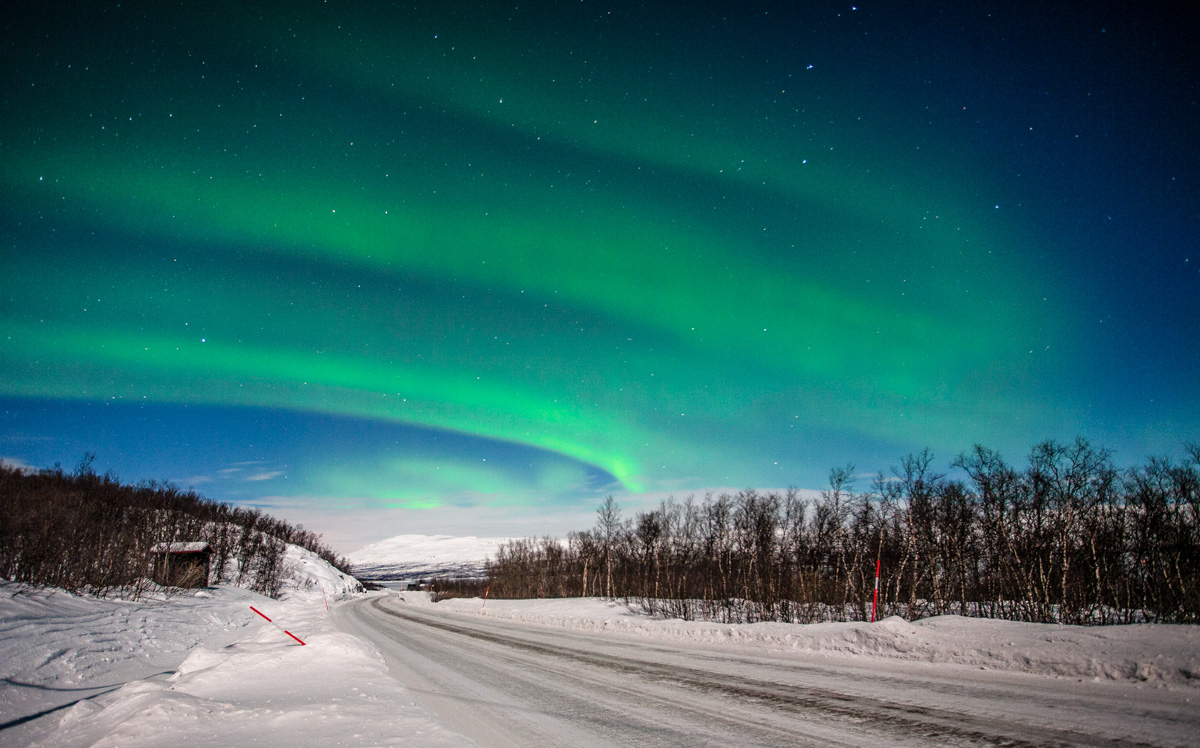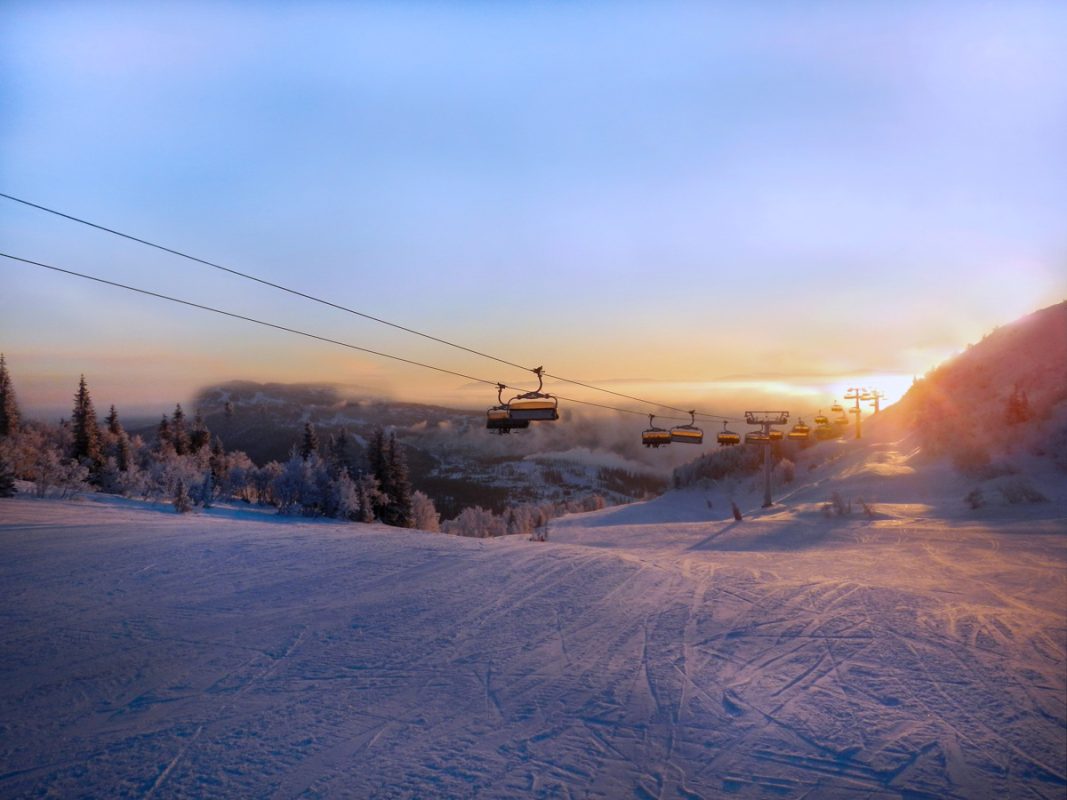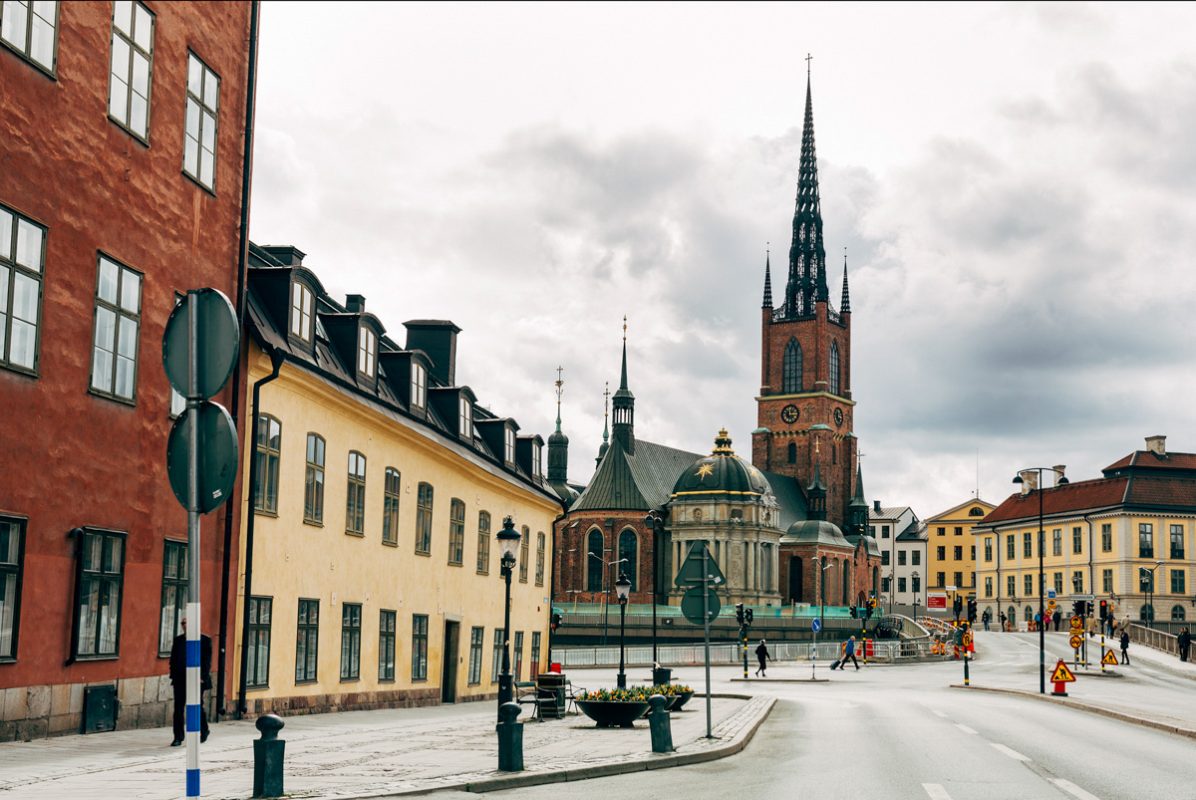If you’re planning a winter trip to Scandanavia, you might be wondering “does it snow in Sweden”?
The answer is it does, but it largely depends on where you’re going and when.
All of Sweden can see snow in the winter period, but it’s much more likely in the north and mountains than on the southern coast.
It’s fairly common in the central area (including Stockholm), but with climate change it’s never guaranteed.
Here’s our full breakdown to snow in Sweden so you know what to expect for a winter trip there!
Does it snow in Sweden?
Yes, it snows plenty in Sweden, but how much you’ll actually see depends hugely on the time of year and where you’re going!
In the northern areas, particularly in Swedish Lapland, snow begins to fall as early as October and lingers until April.
Here, winter’s drawn-out, with both the quantity and duration of snowfall much more than in the south of the country.
Stockholm and central Sweden (Svealand) have a more moderate climate.
Snow’s common from December to February but the cover is typically less deep and the winter season is shorter.
You may well find the city’s cobblestone streets and historic buildings veiled in white, but snow ploughs and salt keep the main roads clear, so life continues much as it does the rest of the year.
Southern Sweden, including cities like Malmö in Skåne County, sees even less snow. Here, winters are milder and snowfall is much more occasional than guaranteed (the snowfall patterns are similar to that of Denmark, south of Sweden).
When does it snow in Sweden?

In Sweden, snowfall starts around late October and can extend up to early April.
Peak snow months are generally December through February.
Does it snow in Sweden in October?
In the north of Sweden, snow may begin in October (usually toward the end of the month).
Meanwhile, central and southern regions like Stockholm and Malmö mostly remain snow-free but the temperatures begin to drop.
Does it snow in Sweden in November?
In November, snow starts accumulating in northern regions like Swedish Lapland.
You might even see a light dusting of snow in Stockholm!
Throughout the country, the days grow shorter and temperatures begin to drop, often below freezing.
Does it snow in Sweden in December?
By December, snowfall becomes widespread across the country.
The northern areas are already well into their snowy season, while cities like Stockholm and Gothenburg see more frequent snowfall.
If you’re travelling around Sweden in the holiday season, expect a mix of snow and ice on the roads!
Does it snow in Sweden in January?
January usually means snow across Sweden.
In northern areas, snow can be substantial and winter activities are common.
In Stockholm and other central regions, the snow is less deep and life continues much as usual thanks to effective snow removal – Swedes deal with snow much better than we do in England!
Does it snow in Sweden in February?
In February, the northern regions remain covered in deep snow, with fantastic winter sports conditions.
Southern parts of Sweden have less frequent snowfall but colder temperatures than January!
Does it snow in Sweden in March?
It varies in Sweden in March.
Northern regions like Lapland still have substantial snowfall, but it’s less frequent in the south.
Daylight starts increasing, signalling the impending end of winter.
Does it snow in Sweden in April?
In April, snow becomes even less common.
While northern regions may still have some snow on the ground, central and southern Sweden generally start to see warmer temperatures.
Where does it snow in Sweden?
It can snow anywhere in Sweden, but northern, more elevated areas are more prone to freezing weather.
Norrland (Including Swedish Lapland)
Norrland covers the northern half of Sweden and envelopes Swedish Lapland.
In cities like Umeå and Luleå, you’ll encounter snowfall from October to April.
Norrland offers a plethora of winter activities, from skiing to snowboarding.
Swedish Lapland (Part of Norrland)

In the extreme northern part of Norrland, Swedish Lapland is famous for its Arctic conditions and unique activities like dog sledging and ice fishing.
Kiruna and Luleå are key cities where the snow remains from October to April.
It’s also worth visiting Abisko to see the Northern Lights!
While these spots aren’t as festive as Roeviemini in Finland, they can make a less touristy alternative if you’re looking for a snowy Christmassy break.
Central Sweden (Svealand)
Located in the middle of Sweden, Svealand includes notable cities like the capital, Stockholm and Uppsala.
Here, you’ll see snow from December to February.
But city life continues almost as usual, thanks to efficient snow removal.
Dalarna County (Central to Northern Sweden)
Dalarna sits within central to northern Sweden and is renowned for its reliable snowfall, making it a haven for skiers.
The snow season typically runs from late November to early April.
Falun and Borlänge are major cities in this region.
Värmland County (West-Central Sweden)
Värmland is located in west-central Sweden, near the Norwegian border.
Karlstad is the main city in this region.
Snow is generally moderate, occuring from December to February.
Västra Götaland (Western Sweden)
This region includes Gothenburg and is situated on Sweden’s western coast.
Snowfall here is lighter and occurs sporadically from December to February.
Skåne County (Southernmost Sweden)

Skåne occupies the southern tip of Sweden, with Malmö as its largest city.
Snow here is rare and typically short-lived. If you’re not a fan of snow, this region offers milder winters.
Gotland and Öland (Swedish Islands)
These Baltic Sea islands lie to the southeast of mainland Sweden. Snowfall is uncommon, aligning with the islands’ overall milder winters.
Does it snow in Stockholm?

Yes, it snows in Stockholm – sometimes intensely – but it’s not as guaranteed as it is up in Lapland!
The snowy usually starts in December and extends all the way through February.
Unlike the more northern reaches of Sweden, Stockholm’s snow is less deep and the winter season is shorter.
Swedes can cope with the snow well – snow ploughs and salt are deployed effectively to keep the main roads clear, so the city functions almost as usual!
However, the cityscape does transform with cobblestone streets, parks, and historic buildings taking on a layer of white.
So, if you’re visiting Stockholm during these months, it’s wise to pack a good pair of boots and prepare for some snow!
Why does it snow in Sweden?
So, why can you expect so much snow in Sweden?
It’s partially down to its geographical location.
Situated in northern Europe, the country falls within the boreal climate zone, extending into the Arctic region in its northernmost part.
This climate features long, harsh winters and short, mild summers, setting the stage for substantial snowfall.
The North Atlantic Drift, an extension of the Gulf Stream, brings warmer temperatures to the coastal regions, but its impact dwindles as you move inland and toward the north.
Cold air masses from the Arctic and Siberia converge over the country, leading to lower temperatures and creating favourable conditions for snow.
The mountain range that spans along Sweden’s border with Norway also contributes.
These mountains act as a barrier, trapping cold air and moisture on the Swedish side, leading to snow, especially in the northern and inland areas.
Elevation is another factor. Higher altitudes in regions like Dalarna and Swedish Lapland see even more snow due to the colder conditions at such elevations.
Finally, Sweden’s latitude ensures that the country experiences short days and long nights during winter, limiting the sun’s warming effect.
This means that the ground stays cold enough for snow to accumulate and last for extended periods.
However, Sweden’s extensive coastline means that it does stay a little warmer than Finland, although technically it sees more snow! Likewise, Norway’s long coastline makes the nation a little wetter, although it does stay milder throughout the winter.
Skiing in Sweden

If you’re a skiing or snowboarding enthusiast, Sweden’s got your winter cravings sorted!
From north to south, the country boasts an array of fantastic ski resorts.
Whether you’re into off-piste adventures, family-friendly slopes, or cross-country skiing, Sweden’s diverse terrains cater to all levels of expertise.
Modern facilities, excellent snow conditions, and a culture that adores winter sports make Sweden a must-visit ski destination.
Åre
Looking for Sweden’s top ski destination? Åre is your place!
The conditions here are fantastic, especially from December to April.
With a variety of trails catering to both beginners and seasoned pros, there’s something for everyone.
Modern lifts and well-maintained slopes make the experience even smoother.
Sälen
Sälen is another excellent choice for skiing enthusiasts, and it’s exceptionally family friendly.
With slopes designed specifically for kids and beginners, Sälen takes the worry out of learning to ski.
But don’t think it’s just for newbies—there are plenty of challenging runs to test your skills too. It’s ideal for all the family!
Idre Fjäll
Idre Fjäll boasts a range of slopes for different skill levels – it’s perfect for groups with varied skiing abilities.
Idre Fjäll is especially popular among off-piste skiers looking for a bit of an adventure.
The resort also encompasses well-groomed cross-country tracks for those who prefer more relaxed skiing!
Tips for Visiting Sweden in the Snow

- Pack Wisely: Given the varying weather conditions, layering is key. Make sure to bring thermal layers, a water-resistant outer layer, and snow boots. Don’t forget gloves and a hat!
- Drive Safely: If you plan on driving, be aware that Swedish roads can be icy. Snow tires are mandatory from December 1 to March 31. Check out the Swedish Transport Administration for current road conditions.
- Public Transport: Sweden has a robust public transport system. Trains and buses are generally on time and well-maintained. For routes and schedules, visit the SJ website.
- Ski Gear: If you’re hitting the slopes, you can either bring your own gear or rent at the resorts. Many places offer online booking for rentals. You can book ski rental in Åre on websites like Skistar.
- Emergency Numbers: Keep a list of emergency numbers. The general emergency number is 112. For health advice, you can call 1177 or visit their website.
- Footwear: City streets can be slippery. Consider shoe grips to avoid any accidents.
